SunsOut
Gold Member
Learn all about the push pull legs routine and how to program an effective PPL workout split.
The post The Definitive Guide to the “Push Pull Legs” Routine appeared first on Legion Athletics.
[h=4]Key Takeaways[/h]
“Push pull legs” routines have been one of the most popular workout splits for decades now.
In fact, just about every time-proven strength and muscle-building program fits this basic mold, and that’s not likely to change.
I’ve been following variations of “PPL” routines for years now, and here’s where it’s gotten me:
Not too shabby.

My bestselling books and workout programs for men and women are also essentially push pull legs routines with additional “accessory” (isolation) work to help bring up “stubborn” body parts like the arms, shoulders, and calves.
The primary reasons push pull legs routines have stood the test of time are they train all major muscle groups, allow plenty of time for recovery, and can be tailored to fit different training goals, schedules, and histories.
They’re easy to understand, too.
At bottom, a push pull legs routine separates your major muscle groups into three different workouts that you do anywhere from 3 to 6 times per week:
By the end of this article, you’re going to know exactly how the push pull legs routine works, who it is and isn’t best for, and how to make the push pull legs routine work for you.
Let’s get to it.
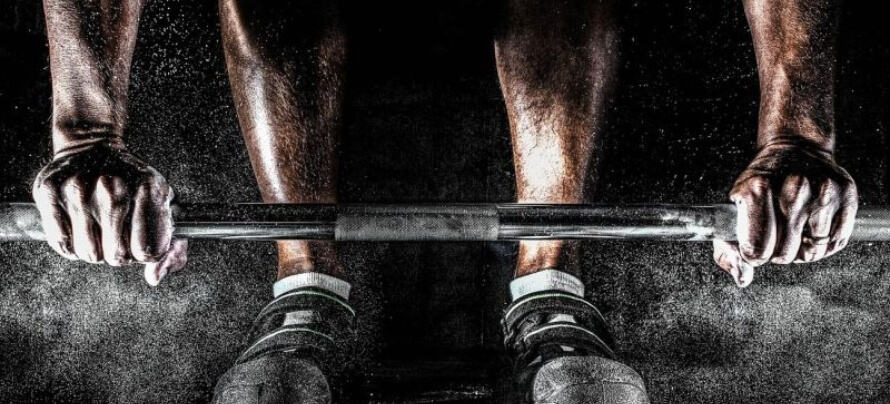
The push pull legs routine, also known as the push/pull/legs or PPL split, is a weightlifting program that has you do three kinds of workouts:
Thus, it’s similar to most “chest and triceps” workouts that you find in other bodybuilding splits.
In a well-designed PPL program, your push workouts will generally revolve around barbell and dumbbell bench pressing, overhead (military) pressing, dipping, and doing isolation exercises for your triceps.
Your pull workouts focus on the muscles involved in your upper body pulling motions, with the major ones being your back muscles and biceps.
Thus, it’s really just a “back and biceps” workout.
These workouts generally revolve around deadlifting, barbell and dumbbell rowing, pulldowns, pull-ups and chin-ups, and doing isolation exercises for your biceps.
And last, your leg workouts focus on training your quads, hamstrings, glutes, and calves.
These workouts generally revolve around squatting, lunging, and doing various isolation exercises for each major muscle group noted above.
In case you’re wondering about your abs, you’ll train your core indirectly through all your compound lifting, but you can add ab exercises at the end of any of these workouts.
So, when you get down to it, the push pull legs split isn’t all that different from many “body part” routines.
The reason I bring this up is body part splits are generally frowned upon these days, but they can be just as effective as anything else when programmed properly.
One of the reasons organizing your training this way is advantageous is muscles generally work in pairs.
For example, when you pull a barbell off the ground, your back muscles and biceps are responsible for generating the force while your chest and triceps are just along for the ride. On the flip side, when you push a heavy barbell off your chest, it’s now your chest and triceps that are the prime movers while your “pull” muscles take the back seat.
That’s why you can blitz your biceps one day and have no issues training your triceps the next.
Likewise, you can pull without issue when your chest, shoulders, or triceps are sore, and you can push or train your legs when your back and biceps are still recovering.
That said, there is a bit of overlap between the muscles involved in each workout, which is why you should always take at least one day off the weights per week.
For example, your lats are involved in bench pressing, and both deadlifting and squatting heavily involve your lower body.
Sending...
Your free stuff is on the way!
Looks like you're already subscribed!
[h=2]What Are the Benefits of Push Pull Legs?[/h]There are several reasons why PPL routines are a staple among bodybuilders and powerlifters.
First, like most good weightlifting programs, they have you spend the majority of your time doing compound exercises.
Compound exercises are movements that involve multiple large muscle groups and require (and develop) the most whole-body strength.
For example, the squat involves moving the knees, ankles, and hips, and requires every muscle in your body to work together, with the quadriceps, hamstrings, glutes, and low-back bearing the brunt of the load.
On the other hand, an exercise like the Russian Leg Curl involves moving the knees and focuses on strengthening the hamstrings and glutes, which is why it isn’t considered a compound exercise.
Now, the reason compound exercises are so important is they’re far better than isolation exercises for gaining strength and size.
They’re not only more efficient in terms of muscle groups trained per exercise, but they also allow for heavier loads to be safely lifted, which makes it easier to continue to progressively overload your muscles.
The only major downside to doing a lot of heavy, compound weightlifting is it’s extremely demanding on your body, both in terms of energy required for workouts and post-workout recovery.
That’s why PPL has you split your upper body into two separate workouts and limits the amount of lower body training that you’re doing every week (which tends to be more taxing).
This way, your muscles have plenty of time to recover between workouts, which allows you to perform better over the long term.
Another major benefit of push pull legs is it can be easily customized to fit your needs and circumstances.
With just three basic workouts to choose from, it’s easy to grasp and think with on the fly and add, subtract, or shift around workouts each week as needed.
For example, the most basic PPL setup looks like this:
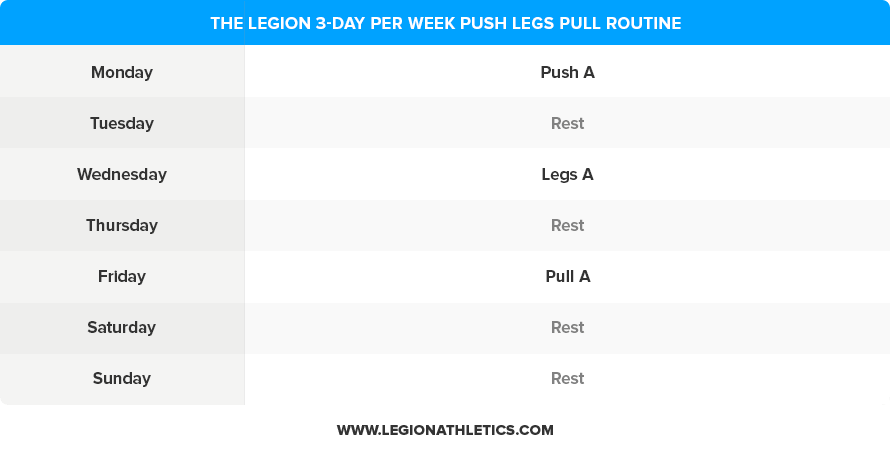
And if you want to train just twice per week, you could do something like this:
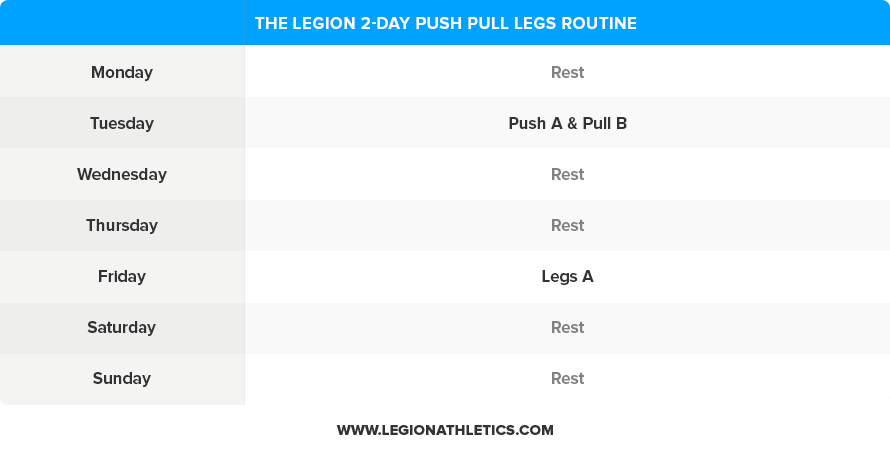
Or, if you want to push yourself to the limit (har har), you could do a six-day per week routine something like this:
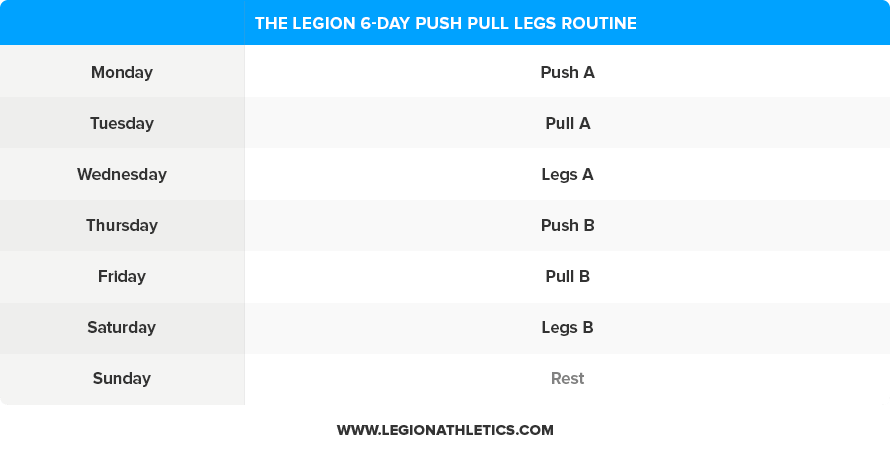
A caveat, however: don’t attempt a routine like this unless you’re an intermediate or advanced weightlifter and either eating for maintenance or lean bulking.

One of the benefits of the push pull legs routine is that it only requires you to learn a handful of exercises. The main ones you want to include in your workouts (and the ones you’ll find in the workouts in this article) are as follows.
[h=3]The Best Push Exercises[/h]The best push exercises are the ones that effectively train your chest, shoulders, and triceps, such as the:
? The Best Chest Workouts for Building Awesome Pecs (According to Science)
? The Best Shoulder Workouts for Men and Women (2020)
? The 6 Best Triceps Workouts for Bigger, Stronger Arms
[h=3]The Best Pull Exercises[/h]The most effective pull exercises are ones that train your back (including lats, erector spinae, and traps) and biceps.
Due to the nature of compound exercises, many of the best pull exercises will also train your rear deltoids, and even your glutes and hamstrings.
Here are some of the best pull exercises:
? The Best Back Exercises to Build Your Best Back Ever
? The Absolute Best Biceps Workout: 5 Biceps Exercises That Build Big Guns
? The 10 Best Exercises for Building Bigger & Stronger Traps (As Fast As Possible)
[h=3]The Best Leg Exercises[/h]When people refer to the “legs day” of a push pull legs routine, what they really mean is “lower body.” That’s because you don’t just want to train your legs—you want to train your entire lower body including your glutes and calves.
With that in mind, the best “legs” exercises are ones that train your quadriceps, hamstrings, glutes, and calves.
Here are some of the best lower body exercises:
? The Ultimate Leg Workout: The Best Leg Exercises for Big Wheels
? The 7 Best Butt Exercises That Will Give You Glorious Glutes
? 4 Calf Exercises That’ll Give You Calves You Can Be Proud Of
[h=2]The Best Push Pull Legs Workout Routines[/h]

So, you’re ready to hit the gym?
Great!
The first thing to decide is how many days per week that you want to train.
If you want to maximize muscle and strength gains and have the time, then I recommend 4 to 6 training days per week.
If you’re short on time, however, or don’t want to train that often for some other reason, then don’t despair—you can still do great with 2 to 3 workouts per week.
Once you’ve decided how many days you’re going to train each week, the next step is turning that into an actual specific routine.
There are many ways of programming PPL workouts, but I’m going to keep it simple and give you a few templates to choose from.
Let’s start with the workouts themselves, and then we’ll see how to combine them into routines.
[h=3]The Push Pull Legs Workouts[/h]You can create an infinite variety of push pull routine workouts, but here are a few of my favorites.
As you’ll see, they involve a lot of heavy, compound weightlifting, supplemented with moderately heavy accessory work.
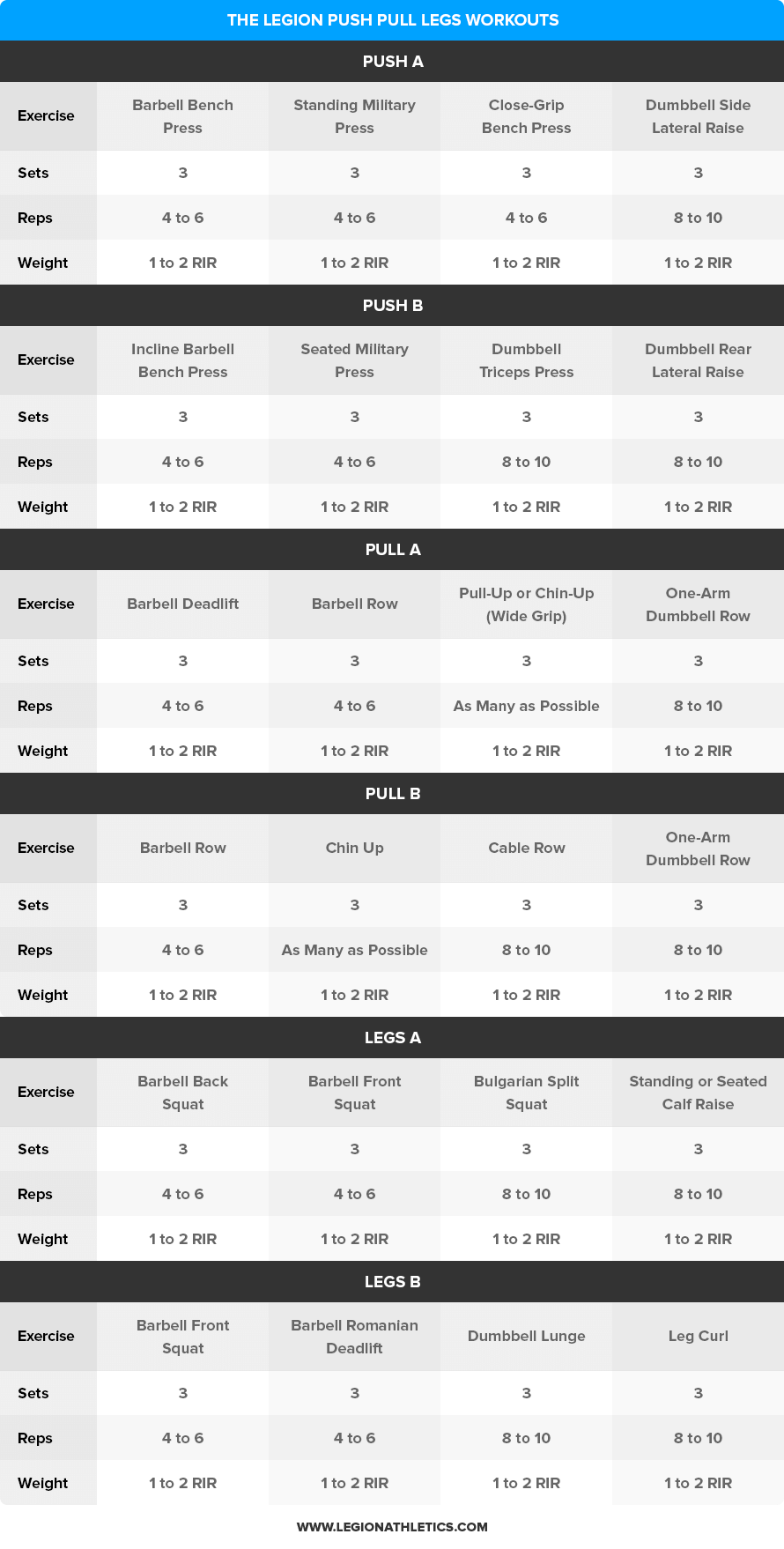
Alright, that’s it for the workouts.
Now let’s see how to turn them into weekly workout routines.
[h=3]The 2-Day Push Pull Legs Routine[/h]As I mentioned earlier, you can do well training just twice per week.
More would be better if you’re trying to gain muscle and strength as quickly as possible, but when circumstances won’t allow for more gym time, this is a solid 2-day routine that you can always fall back on to at least maintain what you’ve got.
Here it is:
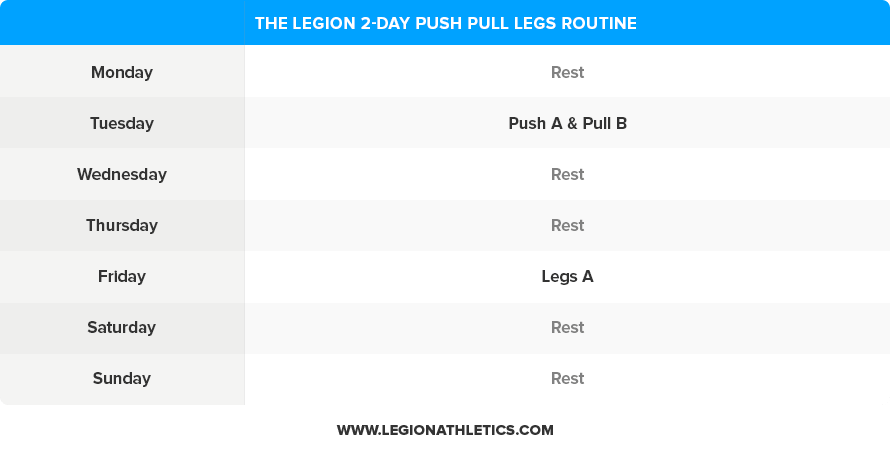
[h=4]Pros and Cons of the 2-Day Routine[/h]Pros
Again, more training is best for maximizing gains, but this 3-day split is a time-proven program for getting big and strong.
Here’s the routine:
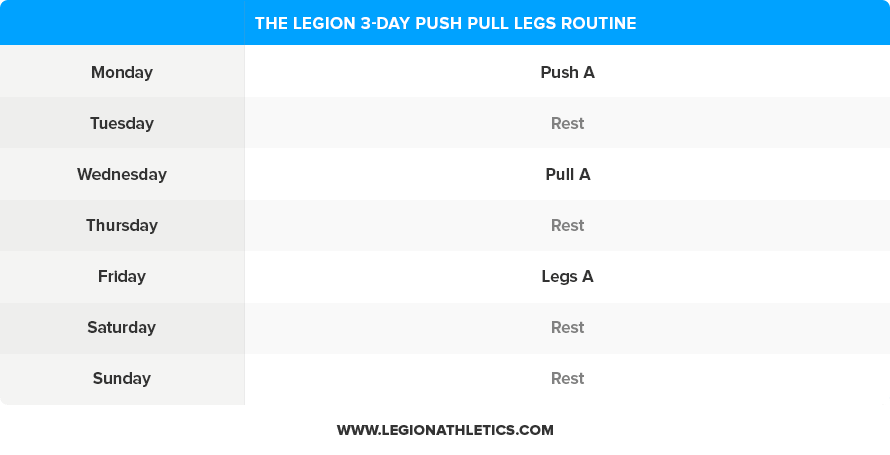
[h=4]The Pros and Cons of the 3-Day Routine[/h]Pros
Thus, I’m going to provide two 4-day routines: one for people that want to focus more on their upper bodies, and one for focusing more on the lower body.
Here they are:
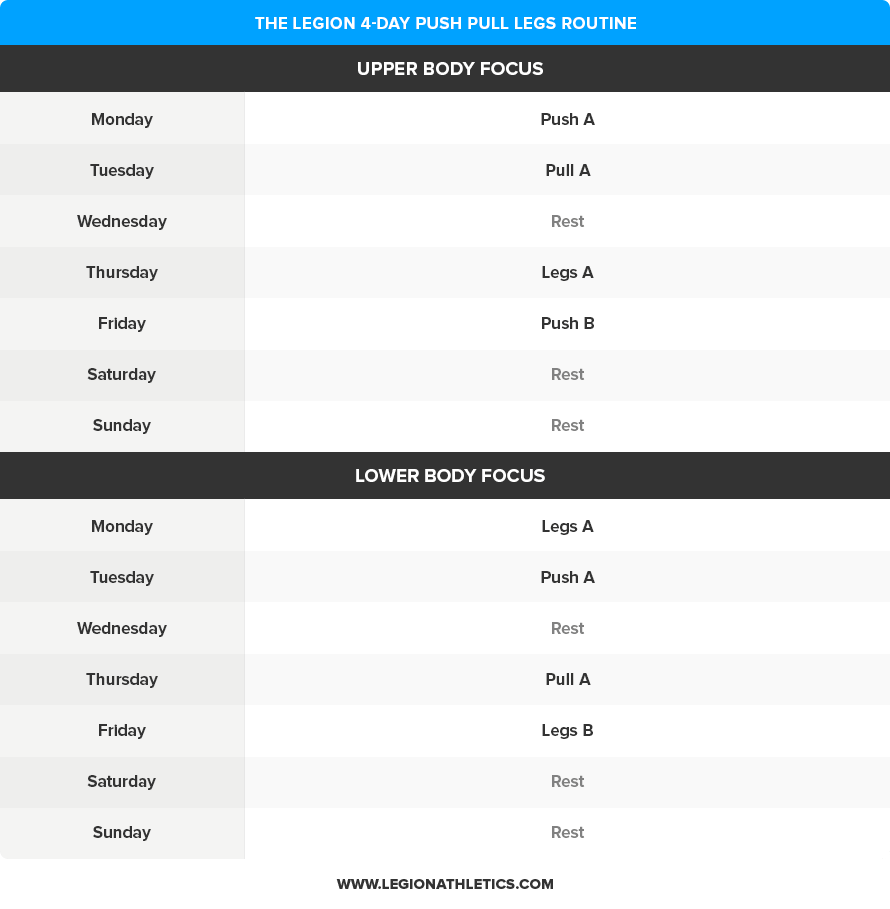
[h=4]The Pros and Cons of the 4-Day Routine[/h]Pros
Again, I’m going to provide two routines here, one for emphasizing the upper body, and one for the lower body.
Here you go:
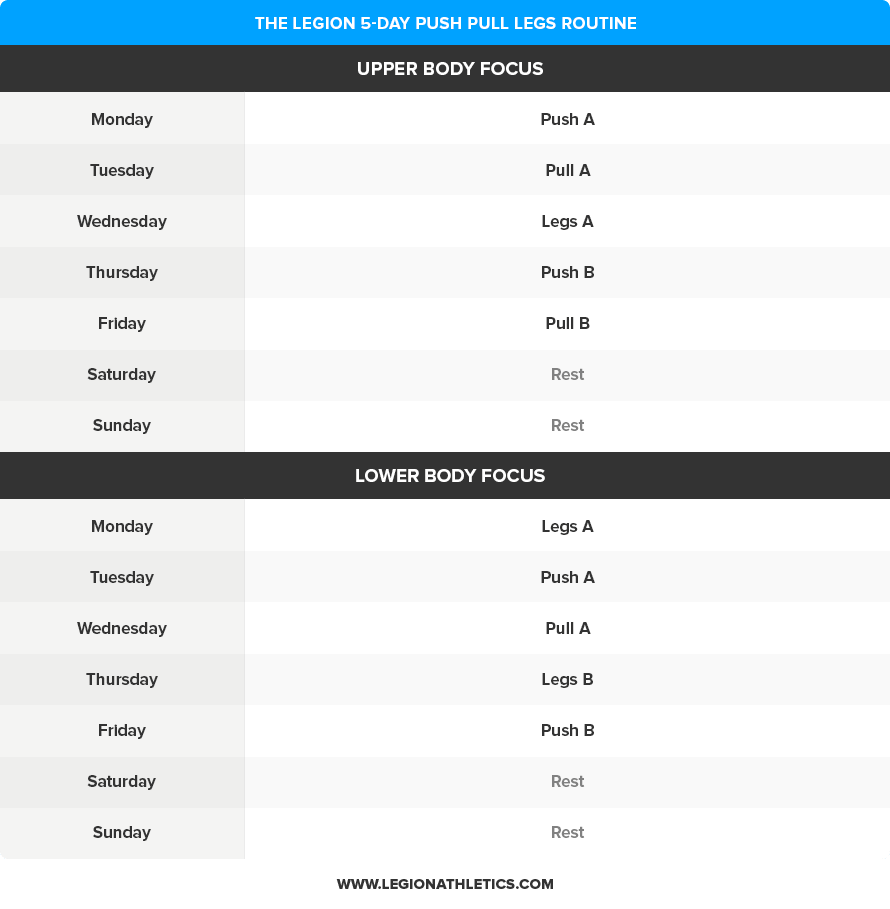
[h=4]The Pros and Cons of the 5-Day Routine[/h]Pros
Seriously though, a 6-day PPL split is about the most a natural weightlifter can get away with until their progress not only stalls but begins to regress.
I don’t recommend it if you’re in a calorie deficit or aren’t recovering well from your current training program for whatever reason (not sleeping enough, stress, aches and pains, etc.). Instead, it’s for when you’re in a calorie surplus and feeling completely up to the challenge.
Here’s the routine:
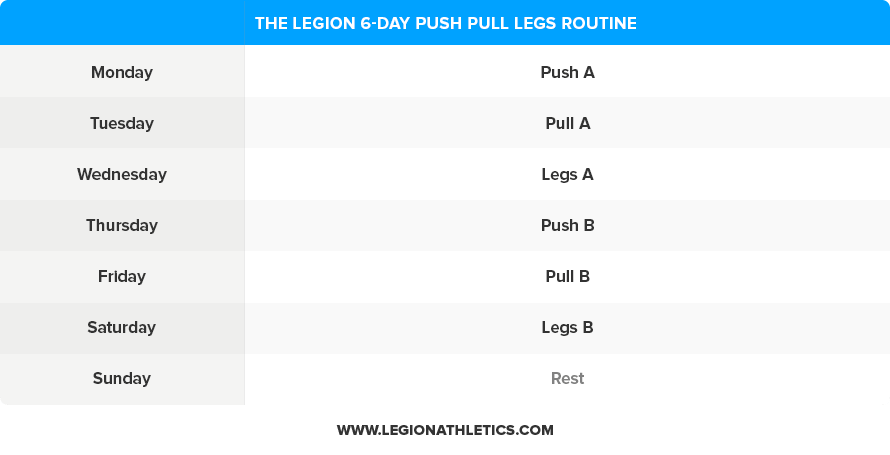
[h=4]The Pros and Cons of the 6-Day Routine[/h]Pros
This setup gives your upper body more time to recover in between workouts but your lower body less time, which means that it’s best suited to people that are more concerned with upper body development than lower body.
Here are several ways to set it up:
[h=3]The 3 Day Push Legs Pull Routine[/h]This gives your upper body a little more recovery time than the normal 3-day push pull legs routine.
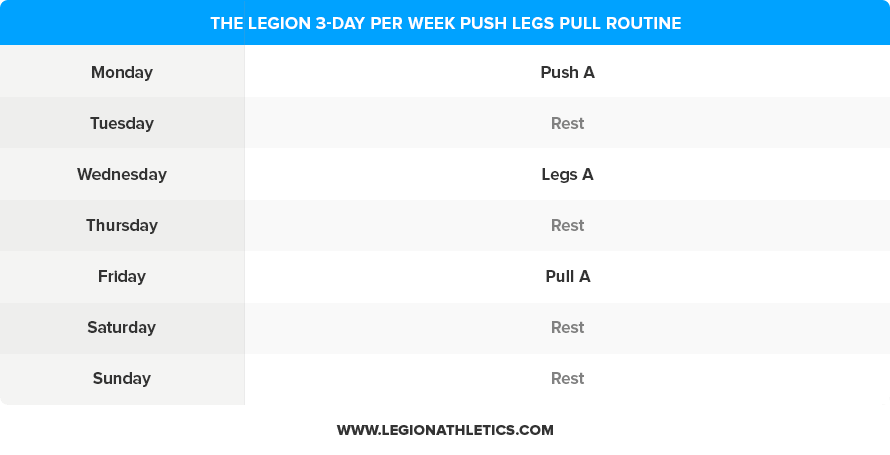
[h=3]The 4 Day Push Legs Pull Routine[/h]Even though push legs pull tends to favor upper body recovery, you can still use a few different variations to change its emphasis.
Here are a couple examples:

[h=3]The 5 Day Push Legs Pull Routine[/h]If you want to push whole-body volume and intensity a little more than with the 4-day routine, this is for you.
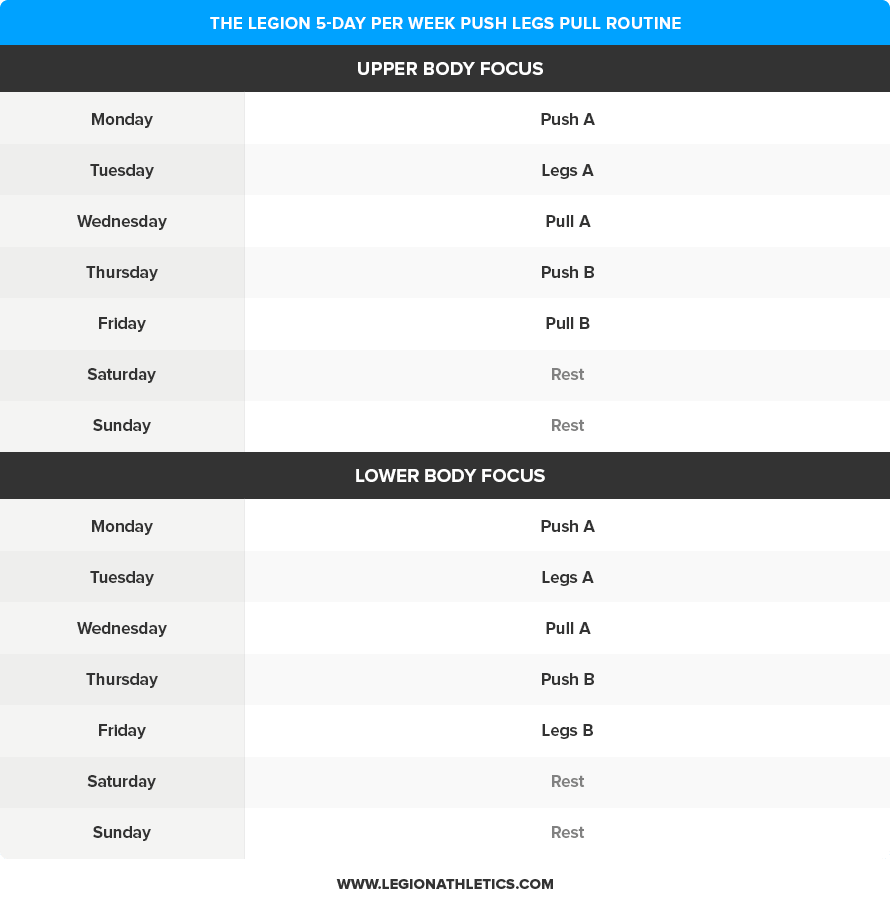
[h=3]The 6-Day Push Legs Pull Routine[/h]If you want to work most on upper body development during your next bulk and are willing to put in the work, this is a fantastic routine.
The same rules apply here as earlier: I don’t recommend this if you’re in a caloric deficit or if you don’t generally feel rested and fresh. It’s best for when you’re fully rested, fed, and ready to train.
Here’s the routine:
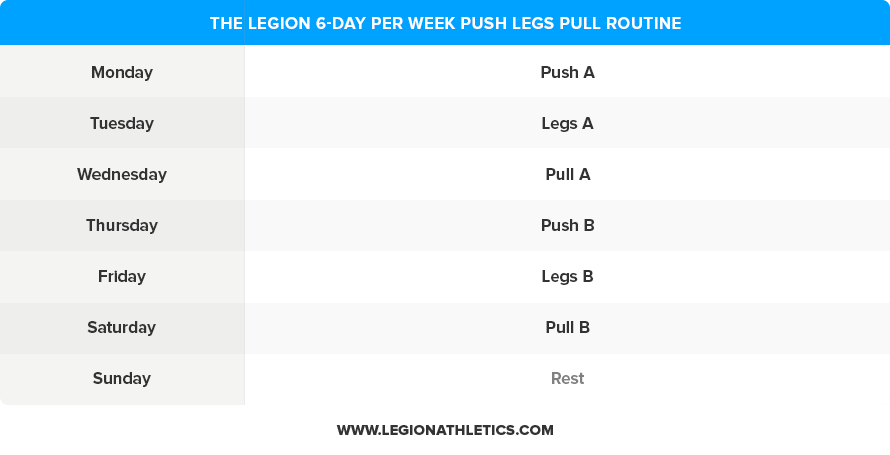
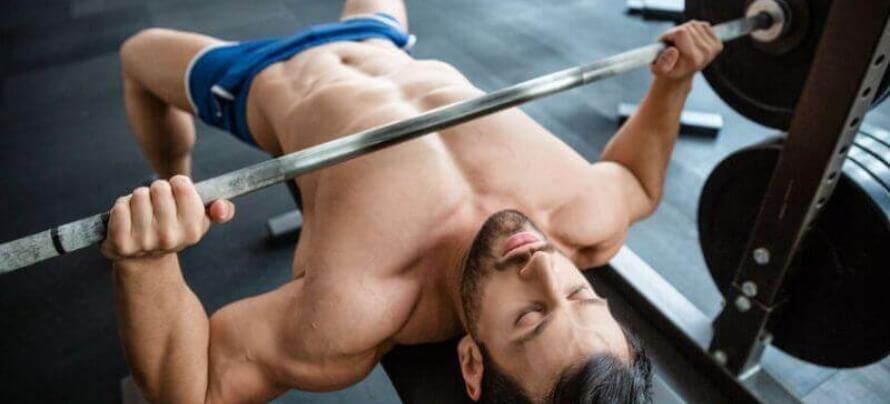
As a natural weightlifter, here’s something you can take to the bank:
If you want to keep getting bigger, you have to keep getting stronger.
This is more important than getting a pump, increasing time under tension, and incorporating special training techniques like rest pause sets, periodization, and the like.
The reason for this is the number-one rule of muscle building is progressive overload, which is the process of gradually increasing the amount of tension on your muscle fibers over time.
You can accomplish this to some degree by continually increasing volume (reps), but ultimately, you also have to add weight to the bar.
That’s why the biggest guys and gals in the gym are generally the strongest.
So, with that in mind, here are several guidelines that will help you get the most out of your push pull legs workouts.
[h=3]Warm up before each workout.[/h]When you warm up for a push pull legs workout (or any other workout), here’s the protocol you want to follow:
After your warm-up and hard sets for the first exercise of your workout, you don’t need to warm up for the rest of the exercises in the workout—your muscles will be plenty warm already.
If you want to learn more about the importance of a proper warm-up and how to warm up for different workouts, check out this article:
? The Best Way to Warm Up For Your Workouts
[h=3]Use Reps In Reserve (RIR) to control workout intensity.[/h]Reps in Reserve (RIR) is a method of controlling your workout intensity, and it works like this:
1 RIR = 1 rep shy of failure
2 RIR = 2 reps shy of failure
3 RIR = 3 reps shy of failure
. . . and so on.
For all of the exercises in these push pull legs workouts, I recommend you use an intensity of 1 to 2 RIR, which means you want to do as many reps as you can within the prescribed rep range until you feel you can only do 1 or 2 reps more and then stop.
For example, if you’re doing 3 sets of 4 to 6 reps of deadlifts, you want to pick a weight that allows you to finish each of your sets feeling like you could have pulled 1 or 2 more reps if you absolutely had to, while completing at least 4 reps and not more than 6.
Check out this article if you want to learn more about how to use Reps in Reserve to improve the effectiveness of your workouts:
? This Is the Best Guide to the RPE Scale on the Internet
[h=3]Once you hit the top of your rep range for one set, add weight.[/h]For instance, if you bench press 225 pounds for 6 reps on your first set, you then add 5 pounds to each side of the bar for your next set.
If, on the next set, you can get at least 4 reps with 235 pounds, that’s the new weight you work with until you can push it for 6 reps, move up, and so forth.
If you get 3 or fewer reps, though, reduce the weight added by 5 pounds (230 pounds) and see how the next set goes. If you still get 3 reps or fewer, reduce the weight to the original 6-rep load (225 pounds) and work with that until you can do two 6-rep sets with it, and then increase the weight on the bar.
This method is known as double progression, which you can learn about in this podcast:
? How to Use Double Progression to Get More From Your Workouts
[h=3]Don’t go to absolute muscle failure every set.[/h]Muscle failure is the point where you can no longer keep the weight moving or maintain proper form and have to end the set.
We should take most of our sets close (but not all the way) to muscle failure.
Research shows taking sets to failure isn’t any more beneficial for muscle growth than taking sets one to two reps shy of failure, and it can increase the risk of injury or burnout. This is particularly true on compound exercises like the squat, deadlift (trap-bar or barbell), bench press, and overhead press.
Thus, this is why I recommend you take all of your sets one to two reps shy of failure (1 to 2 RIR), but not all the way to failure (0 RIR).
You can learn more about how to take sets close (but not to) failure in this article:
? This Is the Best Guide to the RPE Scale on the Internet
[h=3]Rest 3 to 4 minutes in between each set.[/h]This gives your muscles enough time to fully recoup their strength so you can give maximum effort each set.
If you want to learn more about how long you should rest between sets, check out this article:
? How Long Should You Rest Between Sets to Gain Muscle and Strength?
[h=2]5 Supplements to Get the Most Out of Your Push Pull Legs Workouts[/h]

I saved this for last because, frankly, it’s far less important than proper diet and training.
You see, supplements don’t build great physiques—dedication to proper training and nutrition does.
That said, although supplements don’t play a vital role in building muscle and losing fat (and many are a complete waste of money), the right ones can help.
Let’s quickly review the supplements that are going to help you build muscle as quickly as possible.
[h=4]Creatine[/h]Creatine is a substance found naturally in the body and in foods like red meat. It’s perhaps the most researched molecule in the world of sport supplements—the subject of hundreds of studies—and the consensus is very clear:
Supplementation with creatine helps . . .
You may have heard that creatine is bad for your kidneys, but these claims have been categorically and repeatedly disproven. In healthy subjects, creatine has been shown to have no harmful side effects, in both short- or long-term usage. People with kidney disease are not advised to supplement with creatine, however.
If you have healthy kidneys, I highly recommend that you supplement with creatine. It’s safe, cheap, and effective.
In terms of specific products, I recommend Legion Recharge.
Recharge is 100% naturally sweetened and flavored and each serving contains:
So if you want to gain muscle and strength faster and recover better from your workouts, you want to try Recharge today.
[h=4]Whey Protein Powder[/h]You don’t need protein supplements to gain muscle, but considering how much protein you need to eat every day to maximize muscle growth, getting all your protein from whole food can be impractical.
Whey protein is by far the most popular type of protein supplement out there, because you get a lot of protein per dollar spent, it tastes good, and its amino acid profile is uniquely suited to muscle building.
You can take whey protein any time, but it’s particularly effective as a post-workout source of protein because it’s rapidly digested, which causes a dramatic spike in amino acids in the blood.
And if you want an all-natural, delicious whey protein powder, you want to try Whey+.
Whey+ is 100% naturally sweetened and flavored whey isolate that is made from milk sourced from small dairy farms in Ireland, which are known for their exceptionally high-quality dairy.
I can confidently say that this is the creamiest, tastiest, healthiest all-natural whey protein powder you can find. What’s more, you can choose from over a dozen different flavors of Whey+, including French Vanilla, Mocha Cappuccino, and Cinnamon Cereal.
[h=4]Casein Protein Powder[/h]Casein digests slightly slower than whey, providing a steady stream of amino acids to the muscles for growth and repair, which some experts believe may make it a better choice for building muscle.
Most scientific research shows both whey and casein are more or less comparable when it comes to building muscle, so which one you choose largely boils down to personal preference. In terms of which protein powder to choose, you can’t go wrong either way.
And if you want a great-tasting, all-natural casein protein powder, you want to try Casein+.
Casein+ is 100% naturally sweetened and flavored casein isolate also made from milk sourced from small dairy farms in Ireland.
[h=4]Plant-Based Protein Powder[/h]If you don’t eat animal products or want to take a break from whey and casein, you can also get comparable results by taking a plant-based protein powder.
Plant+ is a high-quality blend of pea and rice protein that contains 25 grams of protein per serving. It’s also nutritionally enhanced with 10 added nutrients that vegan and vegetarian diets tend to lack, including vitamin D, beta-alanine, and creatine, as well as 4 digestive enzymes to help you better process and absorb every scoop.
So, if you want a delicious, low-calorie, plant-based protein powder, you want to check out Plant+.
[h=4]Pre-Workout Drink[/h]There’s no question that a pre-workout supplement can get you fired up to get to work in the gym. There are downsides and potential risks, however.
Many pre-workout drinks are stuffed full of ineffective ingredients and/or minuscule dosages of otherwise good ingredients, making them little more than a few cheap stimulants with some “pixie dust” sprinkled in to make for a pretty label and convincing ad copy.
Many others don’t even have stimulants going for them and are just complete duds.
Others still are downright dangerous, like USPLabs’ popular pre-workout “Jack3d,” which contained a powerful (and now banned) stimulant known as DMAA.
Even worse was the popular pre-workout supplement “Craze,” which contained a chemical similar to methamphetamine.
The reality is it’s very hard to find a pre-workout supplement that’s light on stimulants but heavy on natural, safe, performance-enhancing ingredients like beta-alanine, betaine, and citrulline.
And that’s why we sell our own pre-workout supplement. It’s called Pulse and it contains clinically effective doses of six of the most effective performance-enhancing ingredients available:
[h=2]The Bottom Line on the Push Pull Legs Routine[/h]The push pull legs split is one of the simplest and most effective types of weightlifting routines that you can follow.
It trains every major muscle group in your body, it allows you to optimize volume, intensity, frequency, and recovery, and it’s easy to understand and program.
If you’ve never tried it before, you might find that you like it quite a bit more than whole-body or body-part splits.
So, give a routine in this article a go or create your own, and see how your body responds.
I think you’ll be pleasantly surprised!
If you liked this article, please share it on Facebook, Twitter, or wherever you like to hang out online!

[h=3]What’s your take on the push pull legs routine? Have anything else to share? Let me know in the comments below![/h]The post The Definitive Guide to the “Push Pull Legs” Routine appeared first on Legion Athletics.
{feed:enclosure_href }
More...
The post The Definitive Guide to the “Push Pull Legs” Routine appeared first on Legion Athletics.
[h=4]Key Takeaways[/h]
- The push pull legs (PPL) routine is a tried-and-true workout “split” that separates your muscle groups and exercises into push, pull, and legs days.
- PPL routines can be customized for different training frequencies, intensities, and priorities to allow for more or less recovery and volume.
- Keep reading to learn what makes the best PPL routine and to get a free PPL routine you can start following today!
“Push pull legs” routines have been one of the most popular workout splits for decades now.
In fact, just about every time-proven strength and muscle-building program fits this basic mold, and that’s not likely to change.
I’ve been following variations of “PPL” routines for years now, and here’s where it’s gotten me:
Not too shabby.

My bestselling books and workout programs for men and women are also essentially push pull legs routines with additional “accessory” (isolation) work to help bring up “stubborn” body parts like the arms, shoulders, and calves.
The primary reasons push pull legs routines have stood the test of time are they train all major muscle groups, allow plenty of time for recovery, and can be tailored to fit different training goals, schedules, and histories.
They’re easy to understand, too.
At bottom, a push pull legs routine separates your major muscle groups into three different workouts that you do anywhere from 3 to 6 times per week:
- Push workouts: chest, shoulders, and triceps
- Pull workouts: back and biceps (with a bit of hamstrings and glutes as well if you’re deadlifting)
- Legs workouts: quadriceps, hamstrings, glutes, and calves
By the end of this article, you’re going to know exactly how the push pull legs routine works, who it is and isn’t best for, and how to make the push pull legs routine work for you.
Let’s get to it.
- [h=4]Table of Contents[/h]
- What Is the Push Pull Legs Routine?
- What Are the Benefits of Push Pull Legs?
- The Best Push Pull Legs Exercises
- The Best Push Exercises
- The Best Pull Exercises
- The Best Leg Exercises
- The Best Push Pull Legs Workout Routines
- The Push Pull Legs Workouts
- The 2-Day Push Pull Legs Routine
- The 3-Day Push Pull Legs Routine
- The 4-Day Push Pull Legs Routines
- The 5-Day Push Pull Legs Routines
- The 6-Day Push Pull Legs Routine
- Another Option: Push Legs Pull
- The 3 Day Push Legs Pull Routine
- The 4 Day Push Legs Pull Routine
- The 5 Day Push Legs Pull Routine
- The 6-Day Push Legs Pull Routine
- How to Progress in Your Push Pull Legs Workouts
- Warm up before each workout.
- Use Reps In Reserve (RIR) to control workout intensity.
- Once you hit the top of your rep range for one set, add weight.
- Don’t go to absolute muscle failure every set.
- Rest 3 to 4 minutes in between each set.
- 5 Supplements to Get the Most Out of Your Push Pull Legs Workouts
- The Bottom Line on the Push Pull Legs Routine
Would you rather listen to this article? Click the play button below!Want to listen to more stuff like this? Check out my podcast!
[h=2]What Is the Push Pull Legs Routine?[/h] 
The push pull legs routine, also known as the push/pull/legs or PPL split, is a weightlifting program that has you do three kinds of workouts:
- Push workout
- Pull workout
- Legs workout
Thus, it’s similar to most “chest and triceps” workouts that you find in other bodybuilding splits.
In a well-designed PPL program, your push workouts will generally revolve around barbell and dumbbell bench pressing, overhead (military) pressing, dipping, and doing isolation exercises for your triceps.
Your pull workouts focus on the muscles involved in your upper body pulling motions, with the major ones being your back muscles and biceps.
Thus, it’s really just a “back and biceps” workout.
These workouts generally revolve around deadlifting, barbell and dumbbell rowing, pulldowns, pull-ups and chin-ups, and doing isolation exercises for your biceps.
And last, your leg workouts focus on training your quads, hamstrings, glutes, and calves.
These workouts generally revolve around squatting, lunging, and doing various isolation exercises for each major muscle group noted above.
In case you’re wondering about your abs, you’ll train your core indirectly through all your compound lifting, but you can add ab exercises at the end of any of these workouts.
So, when you get down to it, the push pull legs split isn’t all that different from many “body part” routines.
The reason I bring this up is body part splits are generally frowned upon these days, but they can be just as effective as anything else when programmed properly.
One of the reasons organizing your training this way is advantageous is muscles generally work in pairs.
For example, when you pull a barbell off the ground, your back muscles and biceps are responsible for generating the force while your chest and triceps are just along for the ride. On the flip side, when you push a heavy barbell off your chest, it’s now your chest and triceps that are the prime movers while your “pull” muscles take the back seat.
That’s why you can blitz your biceps one day and have no issues training your triceps the next.
Likewise, you can pull without issue when your chest, shoulders, or triceps are sore, and you can push or train your legs when your back and biceps are still recovering.
That said, there is a bit of overlap between the muscles involved in each workout, which is why you should always take at least one day off the weights per week.
For example, your lats are involved in bench pressing, and both deadlifting and squatting heavily involve your lower body.
Summary: The push pull legs routine has you train your “push,” “pull,” and leg muscles on different days. Push pull leg routines closely resemble a “chest and triceps,” “back and biceps,” and “legs” body part split.
[h=2]Get Your Free Push Pull Legs Training Program Now[/h] Enter your email address below to get 12 weeks’ worth of 2, 3, 4, 5, and 6-day per week push pull legs workouts, all expertly laid out in Google Sheets.
Sending...
Your free stuff is on the way!
Looks like you're already subscribed!
[h=2]What Are the Benefits of Push Pull Legs?[/h]There are several reasons why PPL routines are a staple among bodybuilders and powerlifters.
First, like most good weightlifting programs, they have you spend the majority of your time doing compound exercises.
Compound exercises are movements that involve multiple large muscle groups and require (and develop) the most whole-body strength.
For example, the squat involves moving the knees, ankles, and hips, and requires every muscle in your body to work together, with the quadriceps, hamstrings, glutes, and low-back bearing the brunt of the load.
On the other hand, an exercise like the Russian Leg Curl involves moving the knees and focuses on strengthening the hamstrings and glutes, which is why it isn’t considered a compound exercise.
Now, the reason compound exercises are so important is they’re far better than isolation exercises for gaining strength and size.
They’re not only more efficient in terms of muscle groups trained per exercise, but they also allow for heavier loads to be safely lifted, which makes it easier to continue to progressively overload your muscles.
The only major downside to doing a lot of heavy, compound weightlifting is it’s extremely demanding on your body, both in terms of energy required for workouts and post-workout recovery.
That’s why PPL has you split your upper body into two separate workouts and limits the amount of lower body training that you’re doing every week (which tends to be more taxing).
This way, your muscles have plenty of time to recover between workouts, which allows you to perform better over the long term.
Another major benefit of push pull legs is it can be easily customized to fit your needs and circumstances.
With just three basic workouts to choose from, it’s easy to grasp and think with on the fly and add, subtract, or shift around workouts each week as needed.
For example, the most basic PPL setup looks like this:

And if you want to train just twice per week, you could do something like this:

Or, if you want to push yourself to the limit (har har), you could do a six-day per week routine something like this:

A caveat, however: don’t attempt a routine like this unless you’re an intermediate or advanced weightlifter and either eating for maintenance or lean bulking.
Summary: PPL routines emphasize compound exercises, which are more effective than isolation exercises for gaining muscle and strength. PPL routines are also flexible, which allows you to tailor them to how often you can train and how much rest you need.
[h=2]The Best Push Pull Legs Exercises[/h]

One of the benefits of the push pull legs routine is that it only requires you to learn a handful of exercises. The main ones you want to include in your workouts (and the ones you’ll find in the workouts in this article) are as follows.
[h=3]The Best Push Exercises[/h]The best push exercises are the ones that effectively train your chest, shoulders, and triceps, such as the:
- Flat Barbell Bench Press
- Incline Barbell Bench Press
- Flat Dumbbell Bench Press
- Incline Dumbbell Bench Press
- Seated or Standing Military Press
- Close-Grip Bench Press
- Dip
- Side Lateral Raise
- Overhead Triceps Extensions
- Lying Triceps Extension (“Skullcrushers”)
? The Best Chest Workouts for Building Awesome Pecs (According to Science)
? The Best Shoulder Workouts for Men and Women (2020)
? The 6 Best Triceps Workouts for Bigger, Stronger Arms
[h=3]The Best Pull Exercises[/h]The most effective pull exercises are ones that train your back (including lats, erector spinae, and traps) and biceps.
Due to the nature of compound exercises, many of the best pull exercises will also train your rear deltoids, and even your glutes and hamstrings.
Here are some of the best pull exercises:
- Deadlift (sumo, conventional, and trap-bar)
- Barbell Row
- Lat Pulldowns
- Pull-Ups
- T-Bar Row
- Seated Cable Row
- Barbell Curl
- Dumbbell Curl
- Hammer Curl
? The Best Back Exercises to Build Your Best Back Ever
? The Absolute Best Biceps Workout: 5 Biceps Exercises That Build Big Guns
? The 10 Best Exercises for Building Bigger & Stronger Traps (As Fast As Possible)
[h=3]The Best Leg Exercises[/h]When people refer to the “legs day” of a push pull legs routine, what they really mean is “lower body.” That’s because you don’t just want to train your legs—you want to train your entire lower body including your glutes and calves.
With that in mind, the best “legs” exercises are ones that train your quadriceps, hamstrings, glutes, and calves.
Here are some of the best lower body exercises:
- Barbell Back Squat
- Barbell Front Squat
- Leg Press
- Romanian Deadlift
- Lunges (Walking, In-Place, Forward, and Reverse)
- Bulgarian Split Squats
- Leg Curl
- Seated Calf Raise
- Standing Calf Raise
? The Ultimate Leg Workout: The Best Leg Exercises for Big Wheels
? The 7 Best Butt Exercises That Will Give You Glorious Glutes
? 4 Calf Exercises That’ll Give You Calves You Can Be Proud Of
[h=2]The Best Push Pull Legs Workout Routines[/h]

So, you’re ready to hit the gym?
Great!
The first thing to decide is how many days per week that you want to train.
If you want to maximize muscle and strength gains and have the time, then I recommend 4 to 6 training days per week.
If you’re short on time, however, or don’t want to train that often for some other reason, then don’t despair—you can still do great with 2 to 3 workouts per week.
Once you’ve decided how many days you’re going to train each week, the next step is turning that into an actual specific routine.
There are many ways of programming PPL workouts, but I’m going to keep it simple and give you a few templates to choose from.
Let’s start with the workouts themselves, and then we’ll see how to combine them into routines.
[h=3]The Push Pull Legs Workouts[/h]You can create an infinite variety of push pull routine workouts, but here are a few of my favorites.
As you’ll see, they involve a lot of heavy, compound weightlifting, supplemented with moderately heavy accessory work.

Alright, that’s it for the workouts.
Now let’s see how to turn them into weekly workout routines.
[h=3]The 2-Day Push Pull Legs Routine[/h]As I mentioned earlier, you can do well training just twice per week.
More would be better if you’re trying to gain muscle and strength as quickly as possible, but when circumstances won’t allow for more gym time, this is a solid 2-day routine that you can always fall back on to at least maintain what you’ve got.
Here it is:

[h=4]Pros and Cons of the 2-Day Routine[/h]Pros
- Good for people who can only train twice a week
- Effective method of “easing in” to a more serious workout routine
- Probably enough volume to maintain your strength and muscle mass, at least in the short term
- Not enough volume to gain strength and muscle as quickly as possible
- Not enough frequency to master the compound lifts as quickly as possible
- Workouts can get long if you add many accessory exercises for lagging muscle groups
Again, more training is best for maximizing gains, but this 3-day split is a time-proven program for getting big and strong.
Here’s the routine:

[h=4]The Pros and Cons of the 3-Day Routine[/h]Pros
- Good for people who can only train three times per week
- Effective method of “easing in” to a more serious workout routine
- Enough volume to maintain your strength and muscle mass, at least in the short term
- Can work very well for beginners
- Not enough volume to gain strength and muscle as quickly as possible
- Not enough frequency to master the compound lifts as quickly as possible
- Workouts can get long if you add many accessory exercises for lagging muscle groups
Thus, I’m going to provide two 4-day routines: one for people that want to focus more on their upper bodies, and one for focusing more on the lower body.
Here they are:

[h=4]The Pros and Cons of the 4-Day Routine[/h]Pros
- Great for people who can get to the gym four times a week
- Allows you to train either your “push” or lower-body muscles more than once per week
- Approaches an optimum amount of volume for maximizing muscle and strength gain
- Less recovery time between workouts, so you have to be more careful about your sleep, nutrition, etc.
- Two dedicated pushing, pulling, or leg days per week might be more than you need depending on your goals
- Overkill if you just want to maintain your strength and muscle mass on vacation, during a mini-cut, etc.
Again, I’m going to provide two routines here, one for emphasizing the upper body, and one for the lower body.
Here you go:

[h=4]The Pros and Cons of the 5-Day Routine[/h]Pros
- Great for people who can get to the gym five times a week
- Allows for optimum amount of volume for maximizing muscle and strength gain
- Allows you to train either your upper body muscles or lower body muscles more than twice per week
- Requires a fair amount of time spent in the gym
- Less recovery time between workouts means you have to be more careful about your sleep, nutrition, non-weightlifting activities, etc.
- Overkill if you just want to maintain your strength and muscle mass on vacation, during a mini-cut, etc.
Seriously though, a 6-day PPL split is about the most a natural weightlifter can get away with until their progress not only stalls but begins to regress.
I don’t recommend it if you’re in a calorie deficit or aren’t recovering well from your current training program for whatever reason (not sleeping enough, stress, aches and pains, etc.). Instead, it’s for when you’re in a calorie surplus and feeling completely up to the challenge.
Here’s the routine:

[h=4]The Pros and Cons of the 6-Day Routine[/h]Pros
- A great option if you can train six times per week
- Allows for optimum amount of volume for maximizing muscle and strength gain
- Allows you to train either your upper body muscles or lower body muscles more than once per week
- Requires a fair amount of time spent in the gym
- Less recovery time between workouts means you have to be more careful about your sleep, nutrition, non-weightlifting activities, etc.
- Overkill if you just want to maintain your strength and muscle mass on vacation, during a mini-cut, etc.
This setup gives your upper body more time to recover in between workouts but your lower body less time, which means that it’s best suited to people that are more concerned with upper body development than lower body.
Here are several ways to set it up:
[h=3]The 3 Day Push Legs Pull Routine[/h]This gives your upper body a little more recovery time than the normal 3-day push pull legs routine.

[h=3]The 4 Day Push Legs Pull Routine[/h]Even though push legs pull tends to favor upper body recovery, you can still use a few different variations to change its emphasis.
Here are a couple examples:

[h=3]The 5 Day Push Legs Pull Routine[/h]If you want to push whole-body volume and intensity a little more than with the 4-day routine, this is for you.

[h=3]The 6-Day Push Legs Pull Routine[/h]If you want to work most on upper body development during your next bulk and are willing to put in the work, this is a fantastic routine.
The same rules apply here as earlier: I don’t recommend this if you’re in a caloric deficit or if you don’t generally feel rested and fresh. It’s best for when you’re fully rested, fed, and ready to train.
Here’s the routine:

Summary: There are many varieties of PPL routines to choose from, and they all have their pros and cons. The one you should pick depends on how often you can or want to train, what muscle groups you want to prioritize, and how many years you’ve been weightlifting.
[h=2]How to Progress in Your Push Pull Legs Workouts[/h]

As a natural weightlifter, here’s something you can take to the bank:
If you want to keep getting bigger, you have to keep getting stronger.
This is more important than getting a pump, increasing time under tension, and incorporating special training techniques like rest pause sets, periodization, and the like.
The reason for this is the number-one rule of muscle building is progressive overload, which is the process of gradually increasing the amount of tension on your muscle fibers over time.
You can accomplish this to some degree by continually increasing volume (reps), but ultimately, you also have to add weight to the bar.
That’s why the biggest guys and gals in the gym are generally the strongest.
So, with that in mind, here are several guidelines that will help you get the most out of your push pull legs workouts.
[h=3]Warm up before each workout.[/h]When you warm up for a push pull legs workout (or any other workout), here’s the protocol you want to follow:
- Estimate roughly what weight you’re going to use for your three sets of your first exercise (this is your “hard set” weight).
- Do 10 reps with about 50% of your hard set weight, and rest for a minute or two.
- Do 10 reps with the same weight at a slightly faster pace, and rest for a minute or two.
- Do 4 reps with about 70% of your hard set weight, and rest for a minute or two.
After your warm-up and hard sets for the first exercise of your workout, you don’t need to warm up for the rest of the exercises in the workout—your muscles will be plenty warm already.
If you want to learn more about the importance of a proper warm-up and how to warm up for different workouts, check out this article:
? The Best Way to Warm Up For Your Workouts
[h=3]Use Reps In Reserve (RIR) to control workout intensity.[/h]Reps in Reserve (RIR) is a method of controlling your workout intensity, and it works like this:
1 RIR = 1 rep shy of failure
2 RIR = 2 reps shy of failure
3 RIR = 3 reps shy of failure
. . . and so on.
For all of the exercises in these push pull legs workouts, I recommend you use an intensity of 1 to 2 RIR, which means you want to do as many reps as you can within the prescribed rep range until you feel you can only do 1 or 2 reps more and then stop.
For example, if you’re doing 3 sets of 4 to 6 reps of deadlifts, you want to pick a weight that allows you to finish each of your sets feeling like you could have pulled 1 or 2 more reps if you absolutely had to, while completing at least 4 reps and not more than 6.
Check out this article if you want to learn more about how to use Reps in Reserve to improve the effectiveness of your workouts:
? This Is the Best Guide to the RPE Scale on the Internet
[h=3]Once you hit the top of your rep range for one set, add weight.[/h]For instance, if you bench press 225 pounds for 6 reps on your first set, you then add 5 pounds to each side of the bar for your next set.
If, on the next set, you can get at least 4 reps with 235 pounds, that’s the new weight you work with until you can push it for 6 reps, move up, and so forth.
If you get 3 or fewer reps, though, reduce the weight added by 5 pounds (230 pounds) and see how the next set goes. If you still get 3 reps or fewer, reduce the weight to the original 6-rep load (225 pounds) and work with that until you can do two 6-rep sets with it, and then increase the weight on the bar.
This method is known as double progression, which you can learn about in this podcast:
? How to Use Double Progression to Get More From Your Workouts
[h=3]Don’t go to absolute muscle failure every set.[/h]Muscle failure is the point where you can no longer keep the weight moving or maintain proper form and have to end the set.
We should take most of our sets close (but not all the way) to muscle failure.
Research shows taking sets to failure isn’t any more beneficial for muscle growth than taking sets one to two reps shy of failure, and it can increase the risk of injury or burnout. This is particularly true on compound exercises like the squat, deadlift (trap-bar or barbell), bench press, and overhead press.
Thus, this is why I recommend you take all of your sets one to two reps shy of failure (1 to 2 RIR), but not all the way to failure (0 RIR).
You can learn more about how to take sets close (but not to) failure in this article:
? This Is the Best Guide to the RPE Scale on the Internet
[h=3]Rest 3 to 4 minutes in between each set.[/h]This gives your muscles enough time to fully recoup their strength so you can give maximum effort each set.
If you want to learn more about how long you should rest between sets, check out this article:
? How Long Should You Rest Between Sets to Gain Muscle and Strength?
[h=2]5 Supplements to Get the Most Out of Your Push Pull Legs Workouts[/h]

I saved this for last because, frankly, it’s far less important than proper diet and training.
You see, supplements don’t build great physiques—dedication to proper training and nutrition does.
That said, although supplements don’t play a vital role in building muscle and losing fat (and many are a complete waste of money), the right ones can help.
Let’s quickly review the supplements that are going to help you build muscle as quickly as possible.
[h=4]Creatine[/h]Creatine is a substance found naturally in the body and in foods like red meat. It’s perhaps the most researched molecule in the world of sport supplements—the subject of hundreds of studies—and the consensus is very clear:
Supplementation with creatine helps . . .
You may have heard that creatine is bad for your kidneys, but these claims have been categorically and repeatedly disproven. In healthy subjects, creatine has been shown to have no harmful side effects, in both short- or long-term usage. People with kidney disease are not advised to supplement with creatine, however.
If you have healthy kidneys, I highly recommend that you supplement with creatine. It’s safe, cheap, and effective.
In terms of specific products, I recommend Legion Recharge.
Recharge is 100% naturally sweetened and flavored and each serving contains:
- 5 grams of micronized creatine monohydrate
- 2100 milligrams of L-carnitine L-tartrate
- 10.8 milligrams of corosolic acid
So if you want to gain muscle and strength faster and recover better from your workouts, you want to try Recharge today.
[h=4]Whey Protein Powder[/h]You don’t need protein supplements to gain muscle, but considering how much protein you need to eat every day to maximize muscle growth, getting all your protein from whole food can be impractical.
Whey protein is by far the most popular type of protein supplement out there, because you get a lot of protein per dollar spent, it tastes good, and its amino acid profile is uniquely suited to muscle building.
You can take whey protein any time, but it’s particularly effective as a post-workout source of protein because it’s rapidly digested, which causes a dramatic spike in amino acids in the blood.
And if you want an all-natural, delicious whey protein powder, you want to try Whey+.
Whey+ is 100% naturally sweetened and flavored whey isolate that is made from milk sourced from small dairy farms in Ireland, which are known for their exceptionally high-quality dairy.
I can confidently say that this is the creamiest, tastiest, healthiest all-natural whey protein powder you can find. What’s more, you can choose from over a dozen different flavors of Whey+, including French Vanilla, Mocha Cappuccino, and Cinnamon Cereal.
[h=4]Casein Protein Powder[/h]Casein digests slightly slower than whey, providing a steady stream of amino acids to the muscles for growth and repair, which some experts believe may make it a better choice for building muscle.
Most scientific research shows both whey and casein are more or less comparable when it comes to building muscle, so which one you choose largely boils down to personal preference. In terms of which protein powder to choose, you can’t go wrong either way.
And if you want a great-tasting, all-natural casein protein powder, you want to try Casein+.
Casein+ is 100% naturally sweetened and flavored casein isolate also made from milk sourced from small dairy farms in Ireland.
[h=4]Plant-Based Protein Powder[/h]If you don’t eat animal products or want to take a break from whey and casein, you can also get comparable results by taking a plant-based protein powder.
Plant+ is a high-quality blend of pea and rice protein that contains 25 grams of protein per serving. It’s also nutritionally enhanced with 10 added nutrients that vegan and vegetarian diets tend to lack, including vitamin D, beta-alanine, and creatine, as well as 4 digestive enzymes to help you better process and absorb every scoop.
So, if you want a delicious, low-calorie, plant-based protein powder, you want to check out Plant+.
[h=4]Pre-Workout Drink[/h]There’s no question that a pre-workout supplement can get you fired up to get to work in the gym. There are downsides and potential risks, however.
Many pre-workout drinks are stuffed full of ineffective ingredients and/or minuscule dosages of otherwise good ingredients, making them little more than a few cheap stimulants with some “pixie dust” sprinkled in to make for a pretty label and convincing ad copy.
Many others don’t even have stimulants going for them and are just complete duds.
Others still are downright dangerous, like USPLabs’ popular pre-workout “Jack3d,” which contained a powerful (and now banned) stimulant known as DMAA.
Even worse was the popular pre-workout supplement “Craze,” which contained a chemical similar to methamphetamine.
The reality is it’s very hard to find a pre-workout supplement that’s light on stimulants but heavy on natural, safe, performance-enhancing ingredients like beta-alanine, betaine, and citrulline.
And that’s why we sell our own pre-workout supplement. It’s called Pulse and it contains clinically effective doses of six of the most effective performance-enhancing ingredients available:
- Caffeine
- Theanine
- Beta-alanine
- Citrulline malate
- Betaine
- Alpha-GPC
[h=2]The Bottom Line on the Push Pull Legs Routine[/h]The push pull legs split is one of the simplest and most effective types of weightlifting routines that you can follow.
It trains every major muscle group in your body, it allows you to optimize volume, intensity, frequency, and recovery, and it’s easy to understand and program.
If you’ve never tried it before, you might find that you like it quite a bit more than whole-body or body-part splits.
So, give a routine in this article a go or create your own, and see how your body responds.
I think you’ll be pleasantly surprised!
If you liked this article, please share it on Facebook, Twitter, or wherever you like to hang out online!

[h=3]What’s your take on the push pull legs routine? Have anything else to share? Let me know in the comments below![/h]The post The Definitive Guide to the “Push Pull Legs” Routine appeared first on Legion Athletics.
{feed:enclosure_href }
More...

